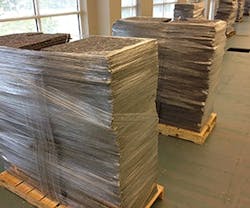The problem of what to do with old carpet is usually swept under the rug, but manufacturers, nonprofit organizations, and lawmakers are coming up with several solutions.
The process has become so easy that when you must face the problem, you'll think you're getting the red carpet treatment. Familiarize yourself with what needs to be done so that the ordeal is smooth and plush.
Know Your Options
The first step is to reach out to dealers and third-party recyclers in your area so you know what's available.
"Most manufacturers and mills will have some kind of recycling program, so they should usually put some options on the table," says Robert Peoples, executive director of nonprofit organization Carpet America Recovery Effort (CARE). "And if they don't have recycling, they can talk to someone who does."
Taking advantage of nearby entities is also the most environmentally responsible route.
"The best option is to do something locally. You don't want to ship carpet all over the place, because that defeats the purpose," explains Eric Nelson, vice president of marketing for manufacturer Interface. "The industry is young, but it's grown to a point where there are a number of options regionally that we can help connect you to." PageBreak
Write a Specification
After deciding on a recycling route, the next step is writing that plan into the job's specification from the very beginning.
"The best thing to do is connect with the manufacturer, designer, or architect and have carpet reclamation specifications incorporated into the bid document upfront," Peoples recommends. "That's an easy no-brainer. Then everything flows smoothly because with the expectation, everyone knows exactly what needs to happen."
Specifying Carpet Reclamation
Make sure your spec hits the highlights.
Designate firm(s) providing removal and recycling.
Inventory items to be removed and recycled.
Require certification(s) that carpet was removed and recycled.
Detail removal of broadloom in 4-feet-wide rolled pieces and tiles on max 36-inch-wide, 4-feet-high pallets.
For a full spec, visit carpetrecovery.org.
If recycling efforts aren't incorporated in the initial phase of the project, trying to recycle the carpet later may come at an additional cost.
"The general contractor needs to know right away to segregate the materials during demolition," says Tom Ellis, vice president of marketing for manufacturer Tandus. "If recycling is an afterthought and people have to scramble to treat the flooring differently, then the scope of work changes and the owner will have to pay for that."
Often recycling carpet is cost-neutral, cost-positive, or no more than $1 per square yard, adds Ellis.
"Throwing stuff in a landfill costs money, and so does recycling. Whether that's more or less expensive depends, but if it's close, the choice is obvious," says Nelson.
Depending on local tip fees, recycling can even save money.
"Rates vary, but a rule of thumb is carpet recycling costs about the same as getting a 30-yard commercial dumpster," Peoples says.
California is the first state to incentivize carpet recycling through AB 2398, the Carpet Stewardship Bill.
Peoples and carpet manufacturers expect other states to follow suit, perhaps by introducing ordinances that prohibit carpet from being left on the curb. On the East and West Coasts, landfill charges are based on weight and biodegradability, so throwing carpet away already comes at a premium. PageBreak
Document the Process
Whoever conducts your reclamation and recycling plan should provide you with some kind of evidence or documentation that your carpet was indeed recycled.
"Sometimes people show initial skepticism about recycling claims and ask, 'How do I know you're not taking my carpet from Virginia and just dumping it in Alabama?'" Ellis explains.
Most manufacturers and nonprofit recyclers will be able to tell you how much material was removed, how much was recycled, and sometimes even what was done with it.
"Some of the carpet is made into new carpet," says John Stephens, vice president of marketing for manufacturer Shaw. "It can also be made into plastic, and a lot of it ends up as waste-to-energy (WtE). We have our own WtE facility that helps power a manufacturing plant."
Securing proof may be slightly more demanding, but it offers benefits.
"Documentation is essential when you're trying to earn LEED credit for waste diversion on a project," says Dave Kitts, environmental vice president at manufacturer Mannington. "It's easy to just gut a building and throw everything in a dumpster. Segregating and recycling takes some upfront rigor and commitment."
Recycling may take an extra phone call, but it's worth it, adds Nelson.
"The more we can figure out how to conserve resources or use the ones we currently have, the better off we'll be," he says. "Recycling is the right thing to do today and the smart thing to do for the future."
Chris Curtland [email protected] is assistant editor of BUILDINGS.
